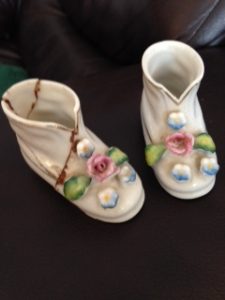Using the Five Senses In Writing
Since I began writing a few years ago, one piece of advice I have heard and read many times is that writers need to show not tell to engage their audiences. How do I show and not simply retell a scene? Beth Goobie, an award winning author of twenty-four published books said during a workshop, “When you are writing, thinking is feeling. If you are stuck in your head you’ll be telling instead of being in your story. To do that you need to incorporate all the senses.”
In other words our head tells the story and our body – our senses – shows the story, allowing readers to be in the story with our characters. How well do I incorporate sight hearing taste, touch, smell and also kinetics – movement into my writing? I find it easy to think about what I want my readers to see and possibly hear, but how often do I incorporate smells which is the sense with the strongest connection to memories?
When I pull out an old photo like this one of my mom, printed in February 1960 and likely taken at Christmas 1959, my memories are pulled to the forefront. I remember her standing at the stove. I visualize her with a dress and an apron working hard to finish the meal we would soon enjoy. It brings to mind the taste of her food, the fragrant aromas that filled the kitchen and wafted throughout the house, tantalizing our tastebuds. But when I write about the memories of my mother in the kitchen, I need to describe what I want the readers to see, hear, taste, smell and touch.
One suggestion Beth offered at the workshop was to write the words taste. . . smell . . . hearing. . . sight. . . touch across the top of the page as a reminder to be in the story and not just think about it. We practiced writing for twenty to thirty minutes highlighting just three senses taste, smell and hearing. This short story could be anything we chose from a memory relived to fiction. We shared some of our rough work before moving on to more writing where we highlighted touch and sight. This time she had a variety of objects. We chose two and incorporated them into the piece we worked on. We could see the objects, handle them to feel their texture.
One final exercise consisted of multiple parts. First she asked us to list ten items that we owned which had a significance or importance to us. Once we completed our list she asked us to pick one item and describe it physically. In the third section of this exercise we needed to write about the emotional meaning of this particular object. Once this section was completed we moved on to writing a step by step description of how we use the object. Finally we needed to use all the portions, the item, description, emotional meaning and how to use it and give the object to a fictional character in a short article or story. It could not be autobiographical.
I found this a daunting task, especially the last part because the object I picked were the ornamental china shoes which had once belonged to my grandmother. I have used the story as a devotional. I have used it as an illustration when I speak and have blogged about them so how could I now pretend they belonged to someone else. It stretched me out of my comfort zone and while that can feel overwhelming at times, it adds to my skill set.
As a writer, do you struggle with adding enough about the senses so you show the story and not simply tell it? As a reader do you notice how much the author pulls you into the story with the senses?
I know this workshop reminded me of the importance of being in the story – living it again or jumping into my imagination and dreaming about what I see, hear, smell, taste and touch in this world I am creating on paper.
Posted: March 13th, 2017 under Storytelling.



